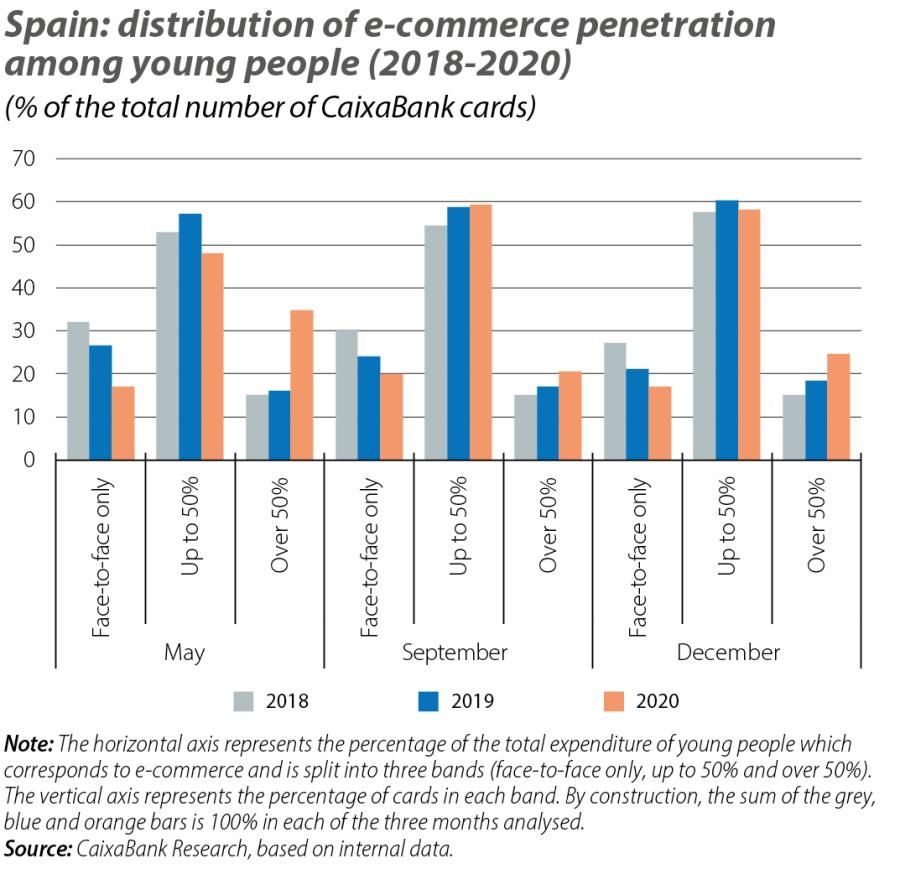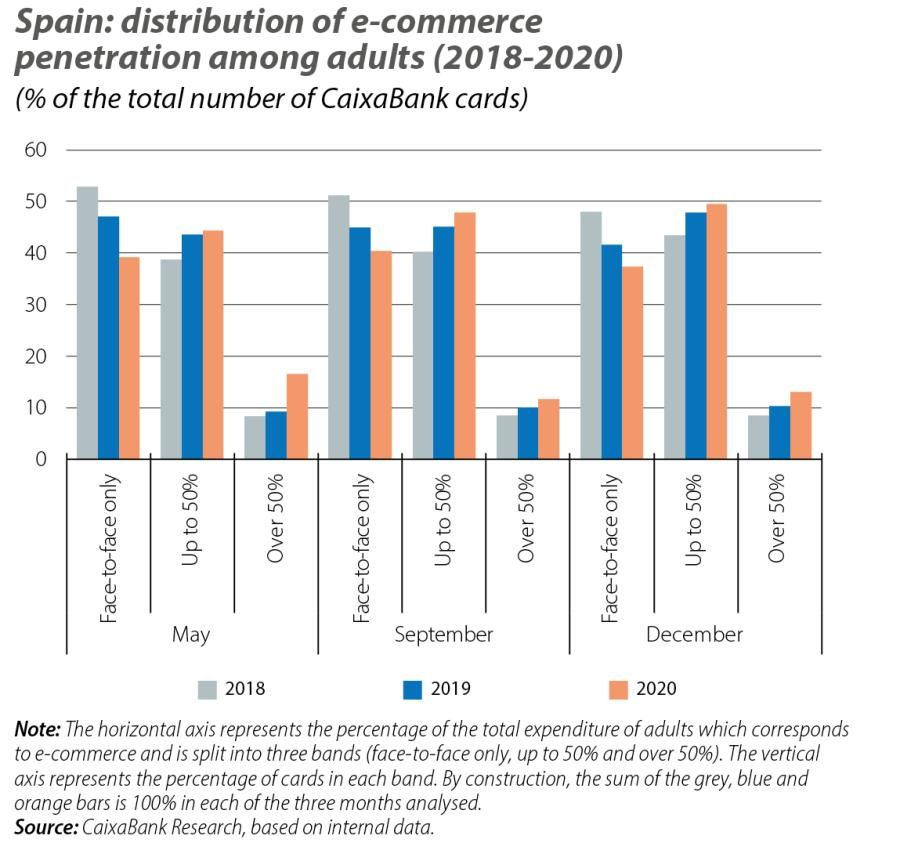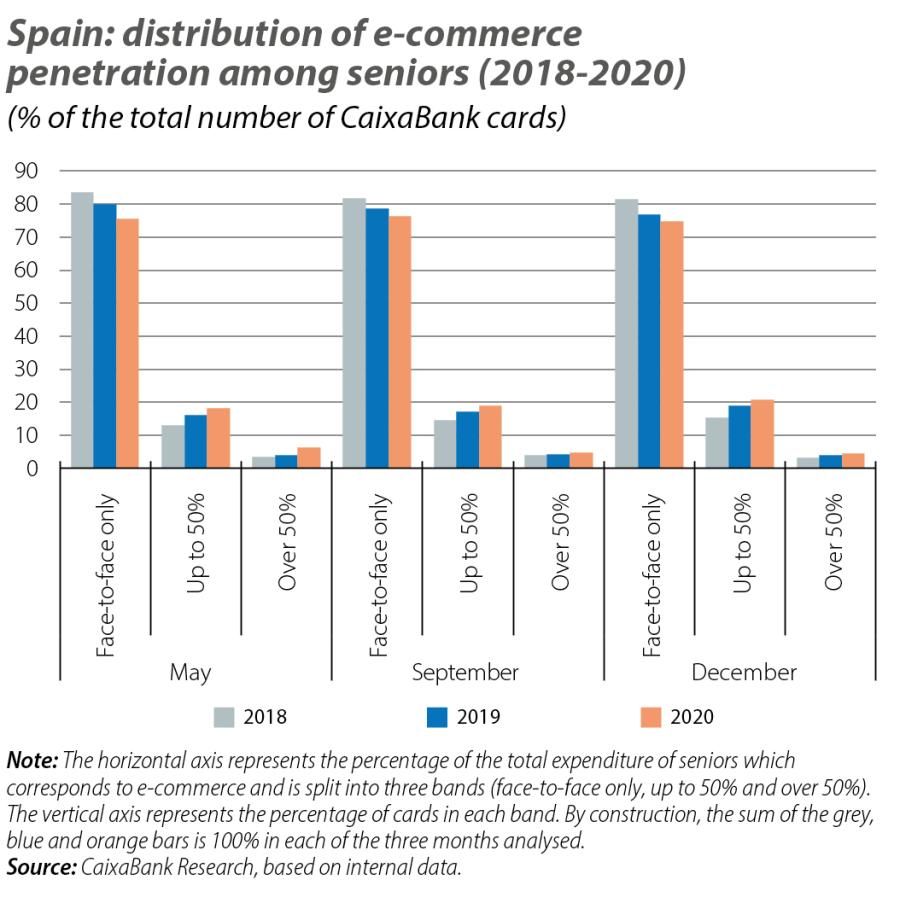The transition to e-commerce during the pandemic: everyone in equal measure?
The COVID-19 crisis has triggered a change in consumption habits in our society and has intensified the use of e-commerce. In this article, we analyse whether this intensification has been uniform across all age groups and constant throughout all phases of the pandemic.

There is no doubt that the outbreak of the pandemic has triggered a change in consumption habits in our society. The social distancing measures and lockdowns imposed to combat the spread of COVID-19 have led many purchases that were previously carried out in person, ranging from a garment of clothing to a household appliance, to move online. The aim of this article is to clarify whether this more intensive use of e-commerce has been uniform across all age groups and also whether it has remained constant throughout all phases of the pandemic.
To answer these questions, as we did in the first article of this Dossier, we have used completely anonymised data on card payments carried out by 13.4 million CaixaBank customers. Firstly, we calculated for each card what proportion of its total expenditure corresponds to online purchases.1,2 Having obtained this proportion, we assign each card a degree of e-commerce penetration, divided into three bands: face-to-face only (0% e-commerce expenditure), moderate penetration (up to 50% of the total expenditure allocated to e-commerce) and high penetration (more than 50% of the total expenditure on e-commerce). Finally, we split all the cards into three age brackets: young (18 to 29 years of age), adult (30 to 64) and senior (65 and over).
- 1It is important to note that the total expenditure data include cash withdrawals at ATMs. Therefore, the substitution of cash payments for card payments during the pandemic would have no effect on our analysis.
- 2The proportion of e-commerce expenditure which we calculated for each card is defined as the ratio between e-commerce payments and the sum of face-to-face card payments, cash withdrawals and e-commerce payments.

The results of this first analysis are shown in the first three charts, which show the picture at three distinct moments of the pandemic: May,3 September and December. At first glance, the numbers fit in with our expectation. On the one hand, seniors are the group with the most exclusive face-to-face consumption. For example, the data tell us that in May 2020 76% of customers in this age group used their cards for face-to-face purchases only. In contrast, the percentage of young people and adults who consumed only face-to-face is significantly lower (especially among young people). On the other hand, across all age groups we can see a historical trend of growth in e-commerce: with each passing year, the percentage of cards with face-to-face consumption only decreases and is offset by an increase in the number of cards categorised as having moderate or high penetration.
- 3May is the first full month after the outbreak of the pandemic with a sufficient level of face-to-face consumption to perform the analysis (in March and April, the mobility restrictions made spending of any kind besides e-commerce or the purchase of essential goods practically impossible).

Analysing how the pandemic has impacted e-commerce spending among the three age groups in further detail, a clear picture emerges: the biggest acceleration in this sales channel occurred in May and was focused mainly among young people (and, to a lesser extent, adults). If we look at young people in particular, in May 2020 35% of them allocated more than 50% of their total card expenditure to e-commerce purchases. This figure is much higher than that of 2018 or 2019 (15% and 16%, respectively). However, note how this acceleration relative to the historical trend is significantly diluted in September, among both young people and adults, whilst in December it once again intensifies, albeit not to the same extent as in May. This disparity in the acceleration of e-commerce relative to the historical trend could be associated with the strictness of the restrictions imposed to curb the spread of COVID-19: part of the acceleration witnessed in May and December can clearly be explained by the situation.4
Continuing with the analysis of young people, another interesting behaviour shown by the data is the trend in the percentage of cards with face-to-face consumption only. In May 2020, the decline compared to 2019 was 10 pps, twice that of 2018 to 2019. This leads us to believe that during the residential lockdown there were many young people who bought online for the first time. To analyse whether the relative importance of this age group in the e-commerce market has changed versus prior years, we can refer to the fourth chart, which shows the expenditure carried out by new users as a proportion of the total for young people (and adults) in each month analysed. These new young buyers accounted for 16-23% (more in May and less in December) of this age group’s total e-commerce expenditure in 2020. In the case of adults, these new buyers accounted for a slightly lower proportion of the total. The relative weight of new buyers falls each year, as one would expect, given that as the e-commerce market grows larger the spending of these new users as a proportion of the total declines.
The same cannot be said for seniors, an age group in which e-commerce consumption did not accelerate relative to the historical trend in any of the three months of 2020 analysed (the increase is very similar to that of 2019), as shown in the third chart. In this regard, the senior age group has shown much more rigidity in its habits during the pandemic compared to young people and adults.5 While it may seem somewhat circumstantial, this persistence of habits limits the potential growth of e-commerce in the short term, given that Spain is a country with a high proportion of elderly people in its population.
- 4Of the months analysed, May was undoubtedly the one with the most restrictions on mobility and activity, since this was precisely when the residential lockdown began to be lifted. In contrast, the restrictions in place in September were much more lax, whilst in December they were once again intensified to contain the second wave of the pandemic.
- 5This should not come as any surprise, since there is extensive literature documenting a positive correlation between age and the rigidity of thought and behaviour. See, for example, W. Schultz and A. Searleman (2002). «Rigidity of thought and behavior: 100 years of research». Genetic Social and General Psychology Monographs.

